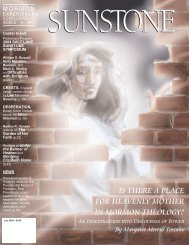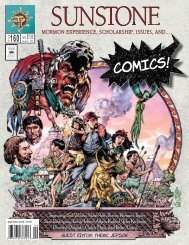Download Entire Issue PDF - Sunstone Magazine
Download Entire Issue PDF - Sunstone Magazine
Download Entire Issue PDF - Sunstone Magazine
Create successful ePaper yourself
Turn your PDF publications into a flip-book with our unique Google optimized e-Paper software.
S U N S T O N E<br />
Al l imAg es : JeAn et t e At w o o d<br />
paying a partial tithing had increased 2 percent, and the<br />
number paying no tithing had risen 17 percent. 8 While this<br />
decline may have been due largely to the effects of the Great<br />
Depression, LDS leaders were still “dumbfounded” at what<br />
they saw as blatant disobedience. “As far as I am concerned,”<br />
Church President Heber J. Grant (1856–1945) insisted, “the<br />
Church is paying these people. If they haven’t enough loyalty<br />
to the Church to do their duty and pay their tithing, I<br />
want it recorded here and now that I want other teachers<br />
there.” 9<br />
Six years later, the situation had not improved. When, in<br />
1940, LDS officials decided that salary increases were to be<br />
granted only to full tithepayers,<br />
BYU’s acting president<br />
reported that “practically<br />
all members whom<br />
we intended to give a small<br />
increase cannot qualify<br />
under this new requirement.”<br />
10 Dismayed, the<br />
First Presidency responded<br />
bluntly: “No person who<br />
has not paid a full tenth of<br />
his Church compensation<br />
for the year 1939 will receive<br />
any advance in salary for the<br />
next school year; that is to<br />
say, the school year 1940–41.<br />
At the end of the next school<br />
year the question of advances<br />
in salaries can be given consideration<br />
to those who have<br />
fully tithed their Church compensation,<br />
and who are otherwise<br />
entitled, under the principles<br />
hereinafter set forth, to<br />
such consideration. The First<br />
Presidency feel that this rule<br />
must be mandatory.” 11 Franklin<br />
Harris remained reluctant, however,<br />
to second-guess a faculty<br />
member’s ability to pay tithing,<br />
and at the time of his resignation<br />
in 1945 (to preside over Utah State University), he had<br />
never disciplined a teacher for tithing-related concerns. 12<br />
“MATTERS OF PRIVATE CONSCIENCE”<br />
WITH HARRIS’S DEPARTURE, the emphasis on faculty<br />
tithe-paying decreased somewhat as attention shifted to<br />
other areas of campus administration, notably how best to<br />
manage the sudden growth of the student body following<br />
World War II. Thus Ernest Wilkinson was both surprised<br />
and chagrined to learn in 1957 that more than a few faculty<br />
members were not full tithepayers. BYU “must pay awfully<br />
low salaries,” he recalled several local Church officials<br />
telling him, sarcastically. 13 Alarmed, Wilkinson met immediately<br />
with LDS President David O. McKay (1873–1970) “on<br />
whether we should insist on payment of tithing by teachers<br />
at the BYU. President McKay shared my opinion,”<br />
Wilkinson reported, “namely, that . . . it was unthinkable<br />
that we retain on our faculty people who do not pay tithing.<br />
He authorized me not only to ask teachers what they do in<br />
this respect, but actually to find out what they do by<br />
checking with the Presiding Bishop’s office and let the<br />
teachers know that I know what their record is.” 14<br />
Wilkinson’s attempt to<br />
gain access to faculty tithing<br />
records proved premature,<br />
however, as Church policy<br />
stipulated that the “amount<br />
of tithing paid by an individual<br />
or by the total ward<br />
membership is confidential<br />
and should not be disclosed<br />
by the bishopric to anyone<br />
except to the stake president<br />
as requested and in<br />
confidential reports to the<br />
General Authorities.” 15<br />
And when McKay’s counselors<br />
in his First<br />
Presidency learned the<br />
extent of the information<br />
that Wilkinson sought,<br />
they decided to withhold<br />
from Wilkinson the<br />
exact amounts of tithing<br />
paid by faculty members.<br />
Undeterred, Wilkinson<br />
arranged to have<br />
the Presiding Bishop’s<br />
office identify for him<br />
any faculty who were<br />
partial- or non-tithepayers,<br />
though without<br />
disclosing the exact<br />
amounts of tithing paid. 16<br />
This, Wilkinson believed, would allow him to doublecheck<br />
the data, if needed, with a faculty member’s local<br />
Church leaders. But the arrangement was not without its<br />
shortcomings. As Wilkinson discovered by the end of<br />
April 1957:<br />
[I] had a conference with a faculty member, advising<br />
him that I could not promote him because<br />
the standards were that he should be faithful to<br />
the standards of the Church, and my understanding<br />
was that he was a non-tithe payer.<br />
Apparently, in this case the report I received from<br />
the stake presidency was wrong. It disturbed the<br />
member no little, as it should. In the evening he<br />
OCTOBER 2011 PAGE 43

















